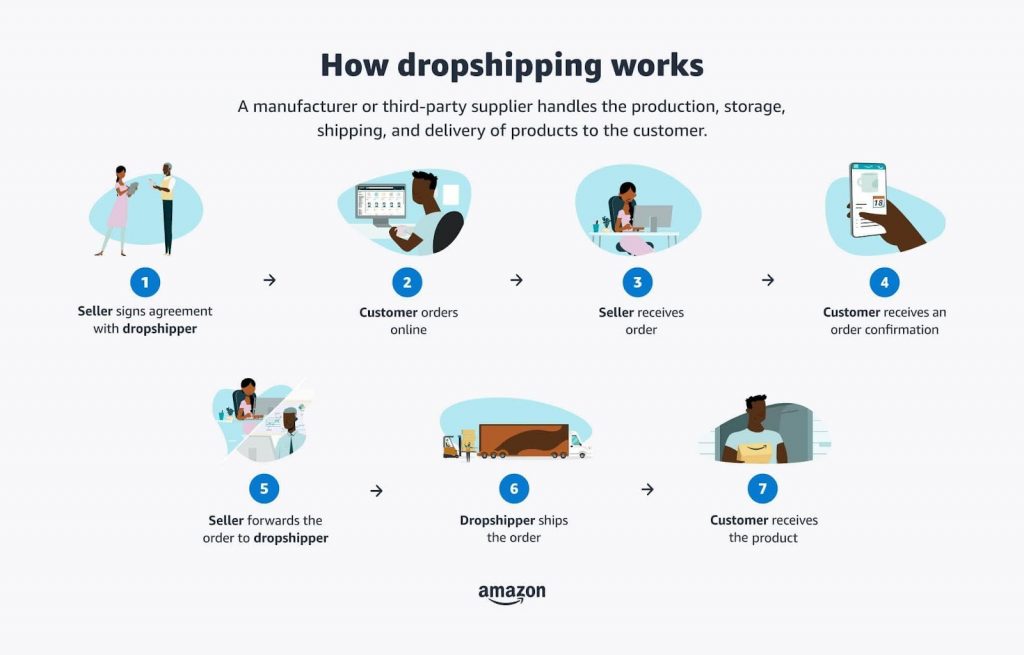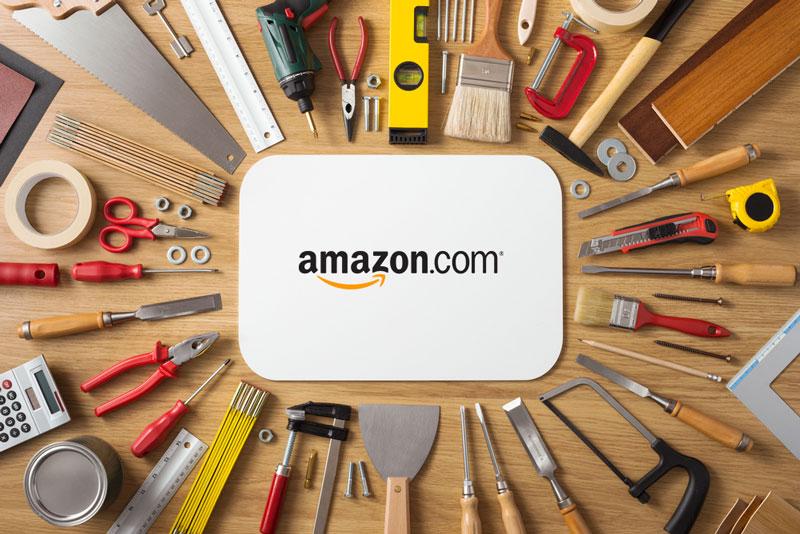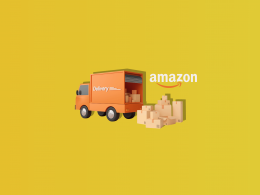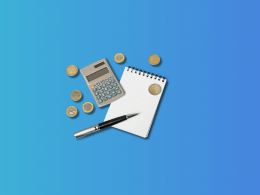If the thought of having your own online retail store has ever crossed your mind, you’ve certainly heard the word “dropshipping” over and over again like some magic spell. Isn’t it magic indeed to have no responsibility for procuring, storing and shipping goods? Sounds like it really is, but let’s look closer at what this fairy-tale magic looks like in real life.
When a newbie entrepreneur enters ecommerce, the first question that troubles their mind isn’t even what to sell, but where to sell for profit.
Amazon, the ecommerce giant founded in 1994 by Jeffrey P. Bezos, has a focus on ecommerce, cloud computing, digital streaming, and artificial intelligence, and has successfully evolved into a multinational and fast-growing ecommerce company.
What makes it so appealing? According to statista.com the United States was Amazon’s biggest market in 2023 with $395.64 billion in net sales. Naturally, this makes Amazon one of the most popular choices to start a business, and dropshipping on Amazon is on the all-time rise.
In this article, we’ll look into dropshipping on Amazon and cover everything you need to know about it.
Contents:
2. How to dropship products on Amazon
3. How to start dropshipping with Amazon account
4. Dropshipping process participants: Customers, dropshippers, Amazon stores and their roles
5. Amazon dropshipping in numbers
- What is the cost of Amazon dropshipping?
- How profitable is dropshipping on Amazon? Amazon dropshipping margins
- What product categories are popular for dropshipping on Amazon?
6. Tips for successful dropshipping on Amazon
7. What is Amazon dropshipping automation?
8. Amazon dropshipping tools and apps
9. Synder for dropshipping business accounting and analytics
10. Amazon dropshipping business benefits and limitations
11. Bottom line

What is dropshipping?
The word dropshipping is fairly self-explanatory: it’s a form of retail business in which a seller transfers customers’ orders directly to a dropshipper who fulfills the order and ships it to a customer. This shows that the intermediary step of buying and storing the goods at the warehouse is skipped. The seller is responsible for marketing and selling the product at their online store, while the dropshipper (whether a manufacturer or wholesaler) takes the responsibility for creating, procuring and shipping the product to the customer.
Amazon also defines dropshipping as “an order fulfillment option that allows ecommerce businesses that start dropshipping on Amazon to outsource procuring, storing, and shipping products to a third party”. That shifts the focus from the way you source your goods to how you actually handle the order.
Amazon’s business models
Let’s get back to the most essential questions for an aspiring ecommerce entrepreneur – Where to sell? and What to sell?
The issue of choosing an ecommerce platform is closely connected to defining a business model you’re going to use. This choice predetermines and sometimes limits the products you choose to sell. There’s a huge difference between selling your handmade items and dropshipping a number of different items that are produced inside or outside the country. According to the Jungle Scout’s 2024 State of the Amazon Seller Report,
It’s necessary to mention that some sellers might use more than one model. What do these models mean?
Private label is the most common model among Amazon sellers. It actually means identifying a product with high demand and low competition, finding a manufacturer to produce it, branding and promoting the product on Amazon.
Wholesale is buying low-cost or discounted items in bulk and then selling them on Amazon as individual units.
Retail Arbitrage is reselling online low-cost or discounted goods purchased from brick-and-mortar retail stores.
Online Arbitrage is finding a low-cost or discounted product on one website or online marketplace and selling them on Amazon.
When you start dropshipping as a business, it means that instead of keeping your own product inventory, you, as an Amazon seller, transfer your customers’ orders directly to a manufacturer or supplier.
Handmade, as prompted by the word itself, is creating your own product by hand and selling on Amazon.
These short business model descriptions actually reveal what you sell and how you procure the goods, including some ways of sourcing the items to sell on Amazon like brick-and-mortar retail stores, online marketplaces, manufacturers and sellers’ creativity in the case of handmade.
How to dropship products on Amazon
If we look into the sequence of steps in a dropshipping model, it would follow this structure (as described by Amazon):
- The seller signs an agreement with a dropshipper and sets up their online store.
- A customer orders online.
- The seller receives an order.
- The customer receives an order confirmation.
- The seller forwards the order to the dropshipper. At this point, the dropshipper charges the seller a price for the product sold, normally wholesale plus a dropshipping fee.
- The dropshipper ships the order.
- The customer receives their product.

How long does it take to start a dropshipping business on Amazon?
On average, dropshipping Amazon goods is more time-consuming in comparison with some other business models. About 56% reported that it took longer than six weeks. 10% of the sellers using dropshipping said it took over a year to get started.
All in all, the initiation process won’t take you long. The main things you need to do are setting up your Amazon account as an Amazon seller and getting approval for your product category.
How to start dropshipping with Amazon account
If you want to start dropshipping on Amazon, you’ll need to do the following:
- Set up an Amazon seller account choosing one of the plans: individual or professional. With the Amazon individual selling plan the seller pays $ 0.99 per item sold, while the Amazon professional selling plan charges $ 39.99 per month, regardless of how many items are sold.
- Find a high-demand and low-competition product to sell on Amazon. Identify the most profitable category, niche to choose what you want to sell on your ecommerce store. There are many ways and tools that can help you find your niche (Trend Hunter, Google Trends, YouTube, AMZscout, Jungle Scout). It requires a bit of research and planning.
- Get Amazon’s approval for your products. This step might be necessary for some categories of product or certain products in the category. Examples of categories that need Amazon’s approval are: Fine Art, Jewelry, Music and DVD, Watches, Collectible Coins, Services and some others.
- Find your dropshippers. This step is of crucial importance as your reputation as the seller of record depends on your dropshipper. So what should you do to find the right one? It’s not the best idea to google only the word “dropshippers” as they mostly work in the B2B sector where SEO or consumer marketing aren’t that important. That’s why dropshippers or suppliers shouldn’t head your search list. Instead, you could try googling a combination of such terms as “wholesaler”, “dropshipper”, “distributor” with the categories of products you intend to sell. While searching, you might want to take a look at an overview of 13 best dropshipping suppliers in 2023 by Shopify, especially if the only option that comes to mind is AliExpress. Yet, it’s worth noting that the Internet isn’t the only search source of potential dropshippers. Many manufacturers will provide you with a list of trusted wholesalers if you contact them.
- Create a listing for the product on Amazon. Amazon gives direct and specific guidelines on creating listings. In a nutshell, there’s a drop-down menu under the Inventory in your seller account. You need to choose “Add a Product” and either match to an existing product detail page in the Amazon catalog or create a new detail page for a product that isn’t yet in the catalog and then create a listing for that product. There are options of creating one listing at a time and creating listings in bulk. You should also remember about Amazon’s fees when setting a price for your product .
- Inform the dropshipper about the order. Once a customer orders from you, deliver the customer’s shipping information to your dropshipper so they can fulfill the order.
Dropshipping process participants: Customers, dropshippers, Amazon stores and their roles
When you start dropshipping on Amazon, first you get to understand how it works. The whole process is seemingly simple, but let’s look at the participants of a dropshipping business closer.
As it was mentioned before, there are sellers, dropshippers and customers.
- Customers are the driver of the whole process. They look for the goods, order and pay for them.
- Dropshippers or suppliers can be divided into manufacturers and wholesalers, providing dropshipping services. In case a manufacturer is also a dropshipper, the product supply chain is shorter and a seller performs the function of a middleman between a manufacturer and a customer. In real life, many manufacturers sell in bulk, which might be an obstacle for your business. If a dropshipper is a wholesaler, the product supply chain is longer, and as there’s more than one middleman, a seller buys from a wholesaler at some markup. That is obviously reflected in the final price.
- Sellers or sellers of record (SoR) are owners of an Amazon store that represent a legal entity selling the product to the end customer. They’re the most interesting part of the chain if we look at it from the point of a dropshipping business. Sellers’ responsibilities are setting the final price for the product, paying the sales tax on a particular sale, recording the purchase as revenue. Sellers of record who chose to work with dropshipping abide by Amazon’s dropshipping policy.
Responsibilities of sellers who use the dropshipping model
According to this policy, sellers who use dropshippers to fulfill the orders should:
1. Sign an agreement with dropshippers that guarantees that they (sellers) will be identified as such on all the documents concerning the products (packing slips, invoices, external packaging);
2. Be responsible for dealing with customer returns of the products sold;
3. Follow all the terms of their seller agreement.
Follow these rules as they’ll help you avoid any confusion. Violating the policy, the seller risks having their account suspended.
Amazon dropshipping in numbers
If the process and participants of dropshipping are quite clear now, one might want to know the numbers that’ll help decide whether this type of fulfillment is appropriate for a particular business and if it’s profitable to start dropshipping as a business. Let’s explore the most typical dropshipping questions asked with the help of Jungle scout, an online tool for growing Amazon business and their report that features information on the survey of about 5000 Amazon sellers.
What is the cost of Amazon dropshipping?
To start selling on Amazon, it’s necessary to set up your Amazon seller account and choose between individual and professional selling plans, which charge their fees. There’s also a referral fee for each item sold. It’s wise to consider all types of fees your business is going to pay to choose the right combination.
Half of the sellers who decided to start dropshipping said that they spent less than $2,500 to start selling on Amazon, 17% – less than $500.
How profitable is dropshipping on Amazon? Amazon dropshipping margins
About 39% of the sellers using dropshipping earn under $5,000 on Amazon with 48% reporting profit margins between 11-25%.
The average dropshipping margin on Amazon is between 10% and 30% with Amazon taking about 15% off.
Considering that your margin is about 30%, you’ll have a margin of 15% after selling a product using Amazon dropshipping. If you’re lucky to win the Amazon Buy Box, these margins increase.
What product categories are popular for dropshipping on Amazon?
The top 5 most popular categories for dropshipping are:
- Home & Kitchen: 50%;
- Sports & Outdoors: 35%;
- Kitchen & Dining: 32%;
- Tools & Home Improvement: 32%;
- Garden & Outdoor: 31%.
Tips for successful dropshipping on Amazon
There are some tips to help you figure out how to deal with Amazon:
- Value your reputation. It’s important to know that connecting your Shopify store to Amazon for dropshipping is fine. You can sell products through dropshipping from different sources. However, dropshipping from other online stores on Amazon is generally not approved of. If customers buy a product from Amazon and receive it with a different retailer’s name, like Walmart or eBay, they might check prices on those platforms and might not come back. Essentially, this is online arbitrage. To keep your business honest and transparent, it’s best to avoid reselling products from other retailers.
- No third-party labels. When using Aliexpress or other suppliers to fulfill your dropshipping orders, make sure to contact your suppliers ahead of time to ensure they won’t ship orders with their company information.
- Get a test order from your supplier. It cannot harm your business to know what you’re about to dropship. Try making test orders from your suppliers preferably without them knowing you’re dropshipping on Amazon. When you receive the goods, look at them from your clients’ perspective: the quality of the product, the unboxing experience, the time it took to get it – everything that can help you win loyal clients.
- Build your brand. It’s surprising sometimes that companies selling identical products can have totally different success rates. Product price in dropshipping gives little competitive advantage as sellers have access to the same suppliers. On the contrary, an attractive brand and impeccable service can help you lure more clients even if your price is the highest in the category.
- Promote your listings. Getting more traffic to your listings is of crucial importance given that you aren’t selling one-of-a-kind products. Amazon’s internal solution is PPC or Pay-per-click. At the same time you can employ external methods like advertising through social networks, using the outreach of influencers, writing a blog or email marketing.
- Automate your processes. Dropshipping on Amazon is challenging for any seller, and as the business grows, managing the processes becomes increasingly difficult. Make selling on Amazon easier by using automated software to optimize and streamline your operations. Fortunately, there are numerous software options available to suit different needs.
Looking for other dropshipping platforms? Learn about eBay Dropshipping business!
What is Amazon dropshipping automation?
Amazon dropshipping automation is the practice in which most of the selling process is done automatically with the help of technology. Basically, merchants can use software to automate various aspects of selling on Amazon, ensuring they save time, money, and other resources.
This practice helps Amazon sellers delegate tasks, making the sales process easier and faster. For example, instead of accepting and processing orders, adjusting prices, providing basic customer support, etc. yourself, an automatic system can arrange this to be done for you.
What will you get from automated dropshipping?
1. Efficiency boost
The main benefit of dropshipping automation is increased efficiency. Instead of doing all the tasks manually, technology takes over all your responsibilities. You set the rules and your technology will follow suit.
For example, you received an order for clothing. Now you need to contact the supplier and complete several more tasks, which will take quite a lot of time. And if the entire process is automated, then it will be accelerated several times.
2. Enhanced accuracy
In business any discrepancies and inaccuracies can lead to costly mistakes. Business automation (and dropshipping automation in particular) eliminates many manual processes, thus efficiently reducing the likelihood of human errors.
For instance, errors associated with incorrect addresses or customer names can slow down service, thereby causing negative customer reactions. After all, it depends on the way you treat your clients whether they decide to come to you again or not in the future. Thanks to quality service, merchants can earn and solidify their reputation, consequently boosting their sales.
3. Less capital required
One of the biggest advantages of dropshipping is that you don’t have to invest a lot of money. You can collaborate with worldwide brands by opening your own dropshipping store. Since your suppliers manufacture, store and ship products, you don’t have to.
Let’s imagine that you are dropshipping clothes. In this scenario, you won’t have to incur expenses such as inventory storage, packaging materials, or shipping fees, as these are handled by the supplier. Instead, your only costs will be related to the contract with the supplier and setting up the system.
4. Competitive advantage
Embracing automation in dropshipping isn’t just about saving time—it’s about gaining a serious edge over the competition. With processes streamlined and time freed up, merchants can dive deep into strategic efforts that set them apart. They can explore various areas, including doubling down on digital marketing, engaging with their community on social media, and staying ahead of the curve by exploring fresh product ideas.
As you can see, dropshipping automation isn’t just about keeping up; it’s about staying steps ahead, continuously innovating, and delivering beyond expectations.
Want to know which tools might help you achieve your goals?
Amazon dropshipping tools and apps

All ecommerce businesses rely on a number of tools and apps as they significantly simplify business processes. And Amazon provides its clients with an ample variety of its own tools for various purposes: from brand building, listings promotion to a revenue calculator. And it’s worth exploring all the opportunities of Amazon.
There are complete tool sets only for Amazon sellers like AMZscout, Jungle Scout, Feedvisor, which provide their clients with a range of options (product tracking, listings builder, advertising analytics, to name but a few) for dropshipping on Amazon.
Other examples of tools include the ones aimed at solving some specific goal: Feedcheck that helps you work with customer reviews over all of your selling channels and improve your products and services, Keepa that tracks the price history of Amazon products and helps estimate a product’s long-term performance – crucial when sourcing products for dropshipping, and Sellery, a real-time Amazon repricing software which creates repricing strategies to win the Buy Box and increase Amazon sales and profits automatically.
Synder for dropshipping business accounting and analytics
The Amazon tools and apps discussed above are examples covering different aspects of an ecommerce business apart from the most essential one – accounting. And Synder is here to help out by providing a smooth reconciliation process and constant support for your Amazon business. It ensures your books are clean and strategies are tweaked when necessary.
Synder has the highest number of integrations, adding more on a regular basis. The platforms available on Synder include all the big ecommerce sales channels like Amazon, Shopify, eBay and more, plus lots of payment gateways like Stripe, Paypal, Square and many others. With the help of the tool, you can connect all the platforms in use with your accounting software and enjoy accurate synchronization of transactions, and easy reconciliation, freeing multiple hours from manual work.
Synder isn’t only a reliable accounting software, but also an ecommerce business intelligence tool. Synder Insights has all your business data analytics on a single dashboard, helping you draw insights into your performance and scale strategically. The best part is – you can connect all channels in use and see your performance across all platforms in one source of truth.
With Synder, you can automate the accounting side of your Amazon business and focus on broadening your dropshipping horizons.
To explore Synder’s automating process and test the software, sign up for a 15-day free trial (no credit card required); or book a seat at our Weekly Public Demo, where you’ll get a guided tour of the tool with a specialist.
Amazon dropshipping business benefits and limitations
Last but not least, every type of business model has its potential benefits and limitations. Dropshipping is no exception here. While it might seem easy to dropship on Amazon, it’s wise to consider whether certain gains are worth the effort. The answer to this question depends on a particular ecommerce business and its goals.

Potential benefits of Amazon dropshipping:
1. Low starting costs
Dropshipping on Amazon might be a good solution for those entrepreneurs who aspire to start their business with minimum investment and risk. Dropshipping option boasts zero up-front costs as you don’t need to have products in stock and then risk shortage or overstock. As it was mentioned before, 17% of businesses that choose to start Amazon dropshipping spend under $ 500.
2. Minimized overhead costs
Amazon dropshipping allows you to economize on manufacturing, storing and shipping the goods, as your only concern is to sell the products. In case your business dropships some of the goods, there’s a lot of potential for some other products or processes that need more attention. A dropshipping business is a relief for those suffering from a packaging and shipping nightmare.
3. Wider outreach
The Amazon dropshipping option gives you the freedom of working from anywhere. Wide range of wholesalers and manufacturers gives the opportunity to sell products that are manufactured in different countries to your customers around the globe. Amazon is represented on 5 continents and ships to over 100 countries providing ecommerce businesses with endless opportunities.
4. Scalability
Huge choice of suppliers with products of all kinds and no need to buy and store the goods allows a business to process more orders, which naturally boosts scalability of Amazon dropshipping.
5. Multi-channel selling
Your ecommerce business can successfully combine selling from your own domain, dropshipping from Amazon or other marketplaces, as well as using social networks to promote and sell goods.
Potential limitations for Amazon dropshipping:
1. High competition
Dropshipping is increasingly competitive as it has low starting costs and every retailer has access to the same number of wholesalers and manufacturers, which means to the same products.
2. Branding issues
As it was just mentioned, the products you procure from dropshippers are hardly unique, which implies that you might want to focus your effort on creating a brand that’ll stand out.
3. Lower profit margins
High competition and products that aren’t distinguished from others in the same category may lead to a lower final price and lower profit margins.
4. Lack of control over product quality
Being the seller of record, you’re responsible for product quality and delivery where you have little involvement and control. This might directly affect your brand name reputation and build long-term relations with your clients.
5. Lack of control over fulfillment
Same as with product quality, you can hardly control all the steps of the fulfillment process. Selection, packaging and shipment are entirely in the hands of your dropshipper. Stock availability is very often not updated every minute, which may result in the situation when a customer orders something out of stock. If something goes wrong in the fulfillment process, you’re the one handling the return process and suffer reputation damage.
6. Fewer special offers for customers
Because you’re not physically fulfilling the order, such options as “free shipping” or “bundles” may not be available for your customers.
Knowing all that, it should be easier to weigh up whether dropshipping is the best option for your ecommerce business. Do you want to start a strong and unique brand? Do you want to dropship generic products? Do the benefits of dropshipping outweigh its shortcomings? These are the questions that a new ecommerce business needs to answer.
Bottom line
After looking into some details and peculiarities of dropshipping on Amazon, it might be easier to decide whether this option satisfies the needs and demands of your business.
Some things are certain though. If you want to grow a successful and honest Amazon business that makes money, think about your clients first, know what you sell, be responsible for handling returns, use appropriate marketing strategies, and don’t neglect useful software. Following these simple tips helps build a long-term and trusting relationship between your business and your clients.

.png)





Best online site